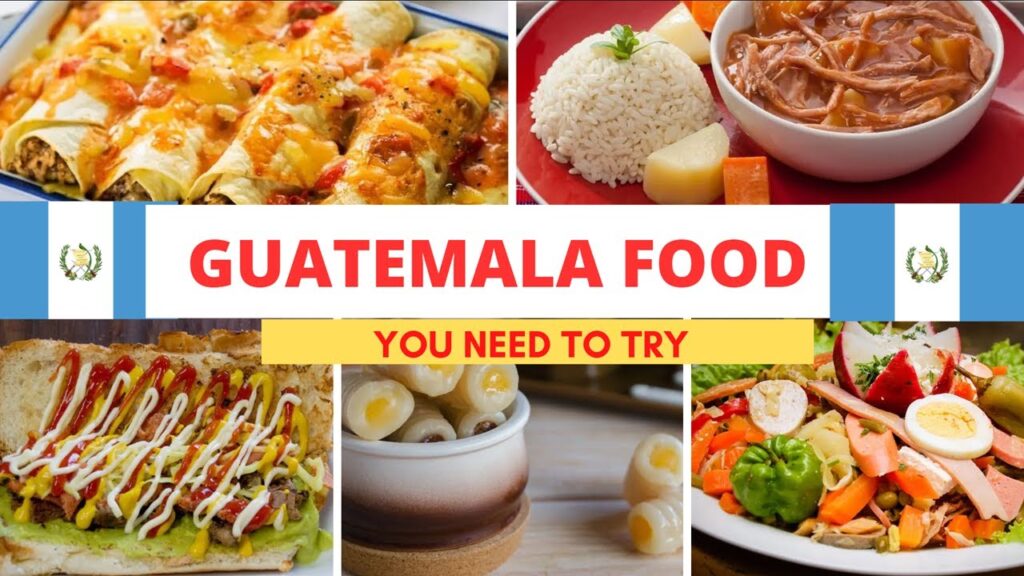Table of Contents
1. Introduction: Why Guatemalan Food is Unique
Guatemalan cuisine is a vibrant fusion of Mayan heritage and Spanish influence. The country’s unique geography, from highlands to coasts, contributes to diverse ingredients and cooking styles, making its culinary scene rich, flavorful, and deeply connected to tradition.
2. Culinary History of Guatemala
- Mayan Roots: Ancient staples like corn, beans, and chili peppers.
- Spanish Influence: Introduction of meats, spices, and baking techniques.
- Fusion: The mix of indigenous and European ingredients created iconic dishes.
3. Staples of Guatemalan Cuisine
- Corn (maize)
- Beans
- Rice
- Squash
- Fresh fruits (plantains, bananas, papaya)
- Local herbs and spices
4. Cooking Techniques and Ingredients
- Stewing and slow cooking (e.g., Pepián)
- Tamales wrapped in banana leaves or corn husks
- Roasting over open flames (volcano-inspired techniques in highlands)
- Use of recados (spice pastes)
5. Top 10 Foods in Guatemala
1. Pepián
A rich meat stew combining chicken or beef with pumpkin seeds, tomatoes, and chili peppers. Often considered a national dish, Pepián is served during celebrations and family gatherings.
2. Kak’ik
A traditional turkey soup spiced with tomatoes, coriander, and chili, originating from Mayan culinary practices. Known for its deep red color and unique smoky flavor.
3. Jocon
Chicken cooked in a green sauce made with tomatillos, cilantro, and green onions. Often served with rice, highlighting the balance of herbs and mild spices.
4. Tamales
Steamed dough made of corn masa, filled with meats, vegetables, or fruits, and wrapped in banana leaves or corn husks. A traditional holiday food, especially during Semana Santa.
5. Rellenitos
Sweet plantain dumplings filled with refried black beans and sometimes chocolate, then fried to perfection. A popular dessert or snack.
6. Hilachas
Shredded beef stew cooked in a tomato-based sauce with potatoes and carrots, reflecting Spanish influence in Guatemalan cuisine.
7. Fiambre
A colorful cold salad eaten during Day of the Dead (Día de los Muertos). Includes cheeses, sausages, vegetables, and pickled items, symbolizing family heritage.
8. Atol de Elote
A sweet corn-based drink, traditionally served hot and enjoyed during breakfast or festive occasions.
9. Chiles Rellenos
Stuffed peppers filled with meat, vegetables, or cheese, typically baked or fried and served with tomato sauce.
10. Pan de Banano
Banana bread flavored with cinnamon and sometimes nuts, widely enjoyed as breakfast or dessert.
6. Street Food Culture in Guatemala
- Pupusas: Stuffed flatbreads sold by street vendors.
- Elotes: Grilled corn on the cob.
- Shucos: Guatemalan hot dogs with unique toppings.
- Street markets offer an immersive food experience.
7. Beverages and Traditional Drinks
- Atol: Sweet corn drinks with variations like atol de elote or atol de chocolate.
- Rosa de Jamaica: Hibiscus flower tea.
- Fresco de Tamarindo: Tamarind drink.
- Guatemalan coffee: Known worldwide for its rich, full-bodied flavor
8. Regional Variations in Guatemalan Cuisine
- Highlands: Hearty stews and tamales.
- Coastal regions: Seafood, coconut-based dishes.
- Northern regions: Spicy and rustic flavors with corn and beans.
9. Festivals and Food Traditions
- Semana Santa: Specialty tamales, Pepián, and Rellenitos.
- Día de los Muertos: Fiambre as a central dish.
- Local fairs celebrating harvests and regional cuisine.
10. Dining Etiquette and Tips
- Share dishes with family-style seating.
- Eat tamales with your hands politely.
- Respect local traditions and avoid wasting food.
- Try local drinks alongside meals.
11. Where to Try the Best Guatemalan Food
- Street markets in Antigua and Guatemala City.
- Local restaurants offering traditional Mayan cuisine.
- Family-owned eateries known for authentic recipes.
- Culinary tours for immersive experiences.
12. Cooking Guatemalan Food at Home
- Use fresh, local ingredients.
- Learn traditional spice pastes (recados) for authentic flavor.
- Prepare tamales or Rellenitos with family or friends.
- Online recipes and cooking classes available.
13. Food Markets and Culinary Tours
- Chichicastenango Market: Famous for traditional dishes and ingredients.
- Central Market in Antigua: Street food and fresh produce.
- Culinary tours teach cooking techniques and cultural history.
14. Health Benefits of Traditional Foods
- Rich in vegetables, beans, and corn.
- Use of fresh herbs and spices for antioxidants.
- Plantain and corn-based dishes provide fiber.
- Moderate portions balance nutrition and taste.
Conclusion
Guatemalan cuisine is a vibrant blend of Mayan and Spanish influences, offering flavors that range from hearty stews to sweet plantain treats. The top 10 foods in Guatemala represent the country’s rich culture, culinary heritage, and passion for sharing meals with family and community. Experiencing these dishes is essential for understanding Guatemalan culture and its traditions.
FAQs About top 10 foods in Guatemala
Q1. What is the national dish of Guatemala?
Pepián is considered one of the national dishes due to its rich history and widespread popularity.
Q2. Are Guatemalan foods spicy?
Some dishes use mild chili peppers, but Guatemalan cuisine is generally flavorful rather than extremely spicy.
Q3. Can I find Guatemalan food outside of Guatemala?
Yes, Guatemalan restaurants exist worldwide, often featuring Pepián, Tamales, and Rellenitos.
Q4. Are traditional foods in Guatemala healthy?
Many dishes are rich in vegetables, corn, and beans, providing fiber and nutrients, though fried sweets like Rellenitos should be enjoyed in moderation.
Q5. What is a must-try dessert in Guatemala?
Rellenitos and Pan de Banano are iconic sweet treats.
Q6. Can I take a cooking class in Guatemala?
Yes, especially in Antigua and Guatemala City, culinary schools offer classes on traditional dishes.
Q7. What beverages are commonly paired with Guatemalan food?
Traditional drinks like Atol, Rosa de Jamaica, and Guatemalan coffee complement meals.
Q8. Which city is best for trying authentic Guatemalan food?
Antigua and Guatemala City are top choices for street food, traditional restaurants, and markets.

